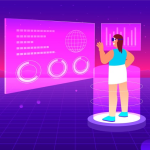In today’s digital age, where virtual reality (VR) and immersive experiences are reshaping how we interact with content, the demand for innovative ways to engage audiences is at an all-time high. One such innovative approach is 360-degree logo animation, a technique that combines the art of logo design with the immersive capabilities of VR technology. This blog explores the concept of 360-degree logo animation, its applications in VR experiences, and its impact on branding and user engagement.
Understanding 360-Degree Logo Animation
Logo animation, traditionally used in videos and digital media, takes on a new dimension in VR with 360-degree capabilities. Unlike traditional animations that are viewed on a flat screen, 360-degree logo animations surround the viewer, creating a fully immersive environment where the logo becomes a part of the user’s spatial experience.
Importance of Logo Animation Services
Logo animation services play a crucial role in enhancing brand identity and user engagement. By transforming static logos into dynamic, interactive elements, companies can differentiate themselves in competitive markets and create memorable experiences for their audiences. This not only reinforces brand recognition but also strengthens emotional connections with consumers.
Benefits of 360-Degree Logo Animation
-
Immersive Brand Experience: By leveraging VR technology, companies can immerse users in their brand story like never before. A 360-degree logo animation places the audience at the center of the brand’s narrative, fostering deeper engagement and brand recall.
-
Interactive Engagement: Unlike traditional media, VR allows for interactivity. Users can explore the logo from different angles, triggering animations or information overlays, creating a personalized and engaging experience.
-
Tech-Savvy Brand Image: Adopting 360-degree logo animation showcases a company’s commitment to innovation and cutting-edge technology. It positions the brand as forward-thinking and adaptive to modern trends, appealing to tech-savvy consumers.
Applications in VR Experiences
-
Marketing Campaigns: Incorporating 360-degree logo animations into VR marketing campaigns can significantly increase their impact. Brands can transport users into virtual worlds where the logo acts as a focal point, delivering key messages in an immersive and memorable way.
-
Product Demonstrations: For product-based companies, showcasing products in VR environments with animated logos can enhance product demonstrations. Users can interact with the product and its branding simultaneously, improving understanding and retention.
-
Virtual Events and Exhibitions: In the era of remote work and digital events, VR offers a compelling alternative to traditional exhibitions. 360-degree logo animations can transform virtual booths and environments, creating a more engaging and interactive experience for attendees.
Technical Implementation
Implementing 360-degree logo animation for VR requires a combination of creative design and technical expertise. Here are key considerations:
-
Design Adaptation: Logos need to be adapted for VR environments to ensure optimal viewing from all angles. This may involve simplifying complex elements or enhancing visual clarity for immersive settings.
-
Animation Techniques: Animators utilize techniques like particle effects, motion graphics, and spatial audio to enhance the immersive experience. Animations should complement the brand’s identity and message while aligning with VR interaction principles.
-
Platform Compatibility: Ensuring compatibility across VR platforms (e.g., Oculus Rift, HTC Vive) is essential for reaching a broad audience. Optimization for different hardware specifications and performance considerations are critical during development.
Case Studies and Success Stories
Several companies have successfully implemented 360-degree logo animations in their VR strategies:
-
Nike: Used VR to launch new products with interactive logo animations that allowed users to explore product features and brand history in a virtual environment.
-
BMW: Enhanced showroom experiences by integrating 360-degree logo animations into virtual car tours, providing customers with an immersive preview of vehicle models.
-
Coca-Cola: Created VR marketing campaigns featuring animated logos that immersed users in branded virtual worlds, driving engagement and brand affinity.
Future Trends and Innovations
Looking ahead, the future of 360-degree logo animation in VR holds exciting possibilities:
-
Augmented Reality Integration: Combining VR with augmented reality (AR) can further enhance interactive branding experiences, blurring the lines between physical and digital environments.
-
AI-driven Personalization: AI technologies can personalize VR experiences based on user behavior and preferences, dynamically adjusting logo animations to maximize engagement.
-
Haptic Feedback: Integrating haptic feedback into VR experiences can amplify sensory engagement, making logo animations more tangible and memorable.
Conclusion
360-degree logo animation in VR represents a paradigm shift in how brands connect with audiences. By leveraging immersive technologies, companies can transcend traditional marketing boundaries, creating impactful brand experiences that resonate deeply with consumers. As VR continues to evolve, the role of animated logo services and the expertise of animated video company will become increasingly pivotal in shaping the future of digital branding.
In summary, 360-degree logo animation services offer not just a visual enhancement but a strategic tool for brands aiming to leave a lasting impression in the dynamic landscape of virtual reality.

